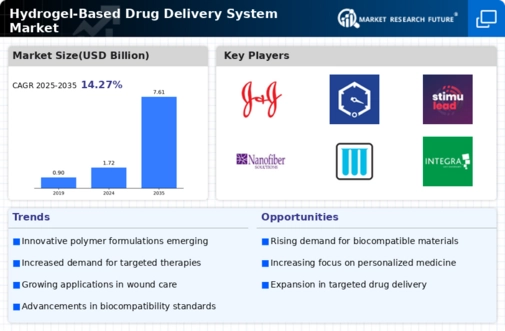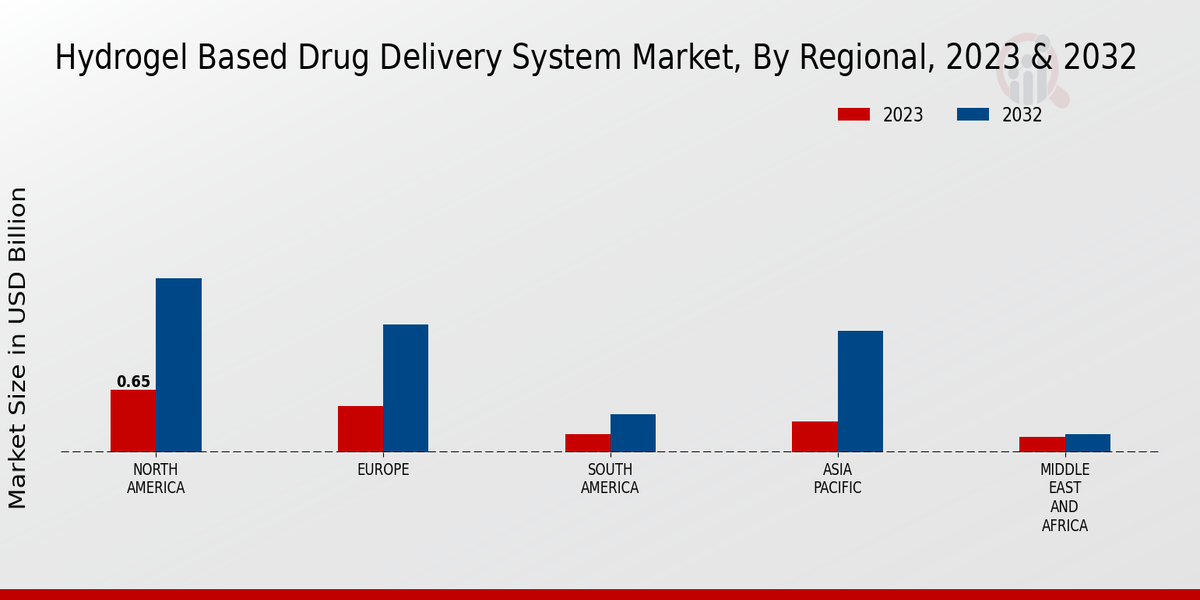Growing Prevalence of Chronic Diseases
The Hydrogel-Based Drug Delivery System Market is significantly influenced by the increasing prevalence of chronic diseases such as diabetes, cancer, and cardiovascular disorders. These conditions necessitate long-term medication regimens, which can benefit from advanced drug delivery systems. Hydrogel-based formulations offer the potential for sustained and controlled release of therapeutic agents, thereby improving patient adherence to treatment protocols. Recent statistics indicate that chronic diseases account for a substantial portion of healthcare expenditures, prompting healthcare systems to seek more efficient treatment modalities. As the demand for effective management of chronic conditions rises, the Hydrogel-Based Drug Delivery System Market is likely to expand, driven by the need for innovative solutions that enhance the quality of life for patients.
Rising Demand for Targeted Drug Delivery
The Hydrogel-Based Drug Delivery System Market experiences a notable increase in demand for targeted drug delivery solutions. This trend is primarily driven by the need for more effective treatment options that minimize side effects associated with conventional therapies. Hydrogel systems, with their unique properties, allow for the controlled release of drugs at specific sites within the body. According to recent estimates, the market for targeted drug delivery is projected to grow significantly, with hydrogel systems playing a crucial role in this expansion. The ability to tailor drug release profiles enhances therapeutic efficacy, thereby attracting interest from pharmaceutical companies and healthcare providers alike. As a result, the Hydrogel-Based Drug Delivery System Market is likely to witness substantial growth in the coming years, driven by innovations in drug formulation and delivery techniques.
Increased Research and Development Activities
The Hydrogel-Based Drug Delivery System Market is witnessing a surge in research and development activities aimed at enhancing hydrogel formulations. This increase is largely attributed to the growing interest in developing novel drug delivery systems that can improve patient outcomes. Research institutions and pharmaceutical companies are investing heavily in exploring new hydrogel materials and their applications in drug delivery. Recent data indicates that R&D spending in the pharmaceutical sector has risen, with a significant portion allocated to innovative drug delivery technologies. This focus on R&D is expected to yield advanced hydrogel systems that offer improved biocompatibility, stability, and drug release characteristics. Consequently, the Hydrogel-Based Drug Delivery System Market is poised for growth as new products emerge from these research initiatives, potentially transforming therapeutic approaches across various medical fields.
Technological Advancements in Hydrogel Manufacturing
The Hydrogel-Based Drug Delivery System Market is experiencing transformative changes due to technological advancements in hydrogel manufacturing processes. Innovations such as 3D printing and microfabrication techniques are enabling the production of complex hydrogel structures with precise control over their properties. These advancements facilitate the development of customized drug delivery systems that can be tailored to meet specific therapeutic needs. Furthermore, the integration of smart technologies into hydrogel systems allows for responsive drug release mechanisms, enhancing their effectiveness. As manufacturing technologies continue to evolve, the Hydrogel-Based Drug Delivery System Market is expected to benefit from increased efficiency and reduced production costs, ultimately leading to a wider adoption of hydrogel-based solutions in clinical settings.
Regulatory Support for Advanced Drug Delivery Systems
The Hydrogel-Based Drug Delivery System Market is positively impacted by regulatory support aimed at promoting advanced drug delivery technologies. Regulatory agencies are increasingly recognizing the potential of hydrogel systems to improve therapeutic outcomes and are streamlining approval processes for innovative drug delivery products. This supportive regulatory environment encourages pharmaceutical companies to invest in the development of hydrogel-based formulations. Recent initiatives by regulatory bodies to establish clear guidelines for the evaluation of new drug delivery systems further enhance the market's growth prospects. As a result, the Hydrogel-Based Drug Delivery System Market is likely to see an influx of new products entering the market, driven by favorable regulatory conditions that facilitate innovation and commercialization.


















Leave a Comment